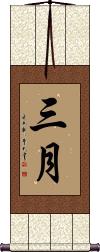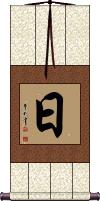Many custom options...
And formats...

Not what you want?
Try other similar-meaning words, fewer words, or just one word.
Feel free to email me with your request. If it's easy, I'll translate it for free and add it to this database of calligraphy for you.
Month of March in Chinese / Japanese...
Buy a Month of March calligraphy wall scroll here!
Personalize your custom “Month of March” project by clicking the button next to your favorite “Month of March” title below...
Month of March
Third Month of the Year
三月 is the Chinese, Japanese, and Chinese way to write the month of March.
This literally reads as “third month” or “third moon.”
This is how to write “day” in Chinese, Japanese, and Korean Hanja.
This can also mean “Sun,” the star in the middle of the Solar system in which we live. In Japanese, it can also mean “sunshine” or even “Sunday.”
When writing the date in modern Chinese and Japanese, putting a number in front of this character indicates the day of the month. Of course, you need to indicate the month too... The month is expressed with a number followed by the character for the moon. So “three moons ten suns” would be “March 10th” or “3/10.”
Note: This is also the first character for the proper name of Japan. Remember that Japan is “The land of the rising sun”? Well, the first character for Japan means “sun” and the second means “origin” so you get the real meaning now. Sometimes, in China, this sun character can be a short name for Japan or a suffix for something of or from Japan.
Not the results for Month of March that you were looking for?
Below are some entries from our dictionary that may match your Month of March search...
| Characters If shown, 2nd row is Simp. Chinese |
Pronunciation Romanization |
Simple Dictionary Definition |
三月 see styles |
sān yuè san1 yue4 san yüeh yayoi やよい |
More info & calligraphy: Month of Marchthree months; (female given name) Yayoi |
卯 see styles |
mǎo mao3 mao bou / bo ぼう |
mortise (slot cut into wood to receive a tenon); 4th earthly branch: 5–7 a.m., 2nd solar month (6th March–4th April), Year of the Rabbit; ancient Chinese compass point: 90° (east); (coll.) to concentrate one's strength (variant of 鉚|铆[mao3]) (1) the Rabbit (fourth sign of the Chinese zodiac); the Hare; (2) (See 卯の刻) hour of the Rabbit (around 6am, 5-7am, or 6-8am); (3) (obsolete) east; (4) (obsolete) second month in the lunar calendar; (personal name) Bou |
寅 see styles |
yín yin2 yin fusa ふさ |
3rd earthly branch: 3-5 a.m., 1st solar month (4th February-5th March), year of the Tiger; ancient Chinese compass point: 60° (1) the Tiger (third sign of the Chinese zodiac); (2) (obsolete) (See 寅の刻) hour of the Tiger (around 4am, 3-5am, or 4-6am); (3) (obsolete) east-northeast; (4) (obsolete) first month of the lunar calendar; (surname) Fusa |
三月尽 see styles |
sangatsujin さんがつじん |
last day of March; last day of the third lunar month (marking the end of spring) |
制怛羅 制怛罗 see styles |
zhì dá luó zhi4 da2 luo2 chih ta lo Seitanra |
Caitra, the spring month in which the full moon is in this constellation, i. e. Virgo or 角; M. W. gives it as March-April, in China it is the first month of spring from the 16th of the first moon to the 15th of the second. Also idem 制多 caitya. |
怛囉麽洗 see styles |
dá luō xǐ da2 luo1 xi3 ta lo hsi |
Caitra-māsa, tr. as the 正月 or first month; M. W. gives March-April. |
頗勒具那 颇勒具那 see styles |
pǒ lè jun à po3 le4 jun4 a4 p`o le chün a po le chün a |
(or 頗勒窶拏) Phālguna, the twelfth month in India (February-March). |
叵囉虞那麽洗 see styles |
pǒ luō yú nà xǐ po3 luo1 yu2 na4 xi3 p`o lo yü na hsi po lo yü na hsi |
叵勒拏; 頗攞遇捉; 頗勒窶拏 phālgunamāsa, the twelfth month; M. W. says February-March, the month, māsa, of the Nakṣatra Phālgunī. |
Variations: |
sangatsu さんがつ |
(1) March; (2) third month of the lunar calendar |
The following table may be helpful for those studying Chinese or Japanese...
| Title | Characters | Romaji (Romanized Japanese) | Various forms of Romanized Chinese | |
| Month of March | 三月 | mitsuki / sangatsu | sān yuè / san1 yue4 / san yue / sanyue | san yüeh / sanyüeh |
| Day | 日 | hi / nichi | rì / ri4 / ri | jih |
Successful Chinese Character and Japanese Kanji calligraphy searches within the last few hours...





